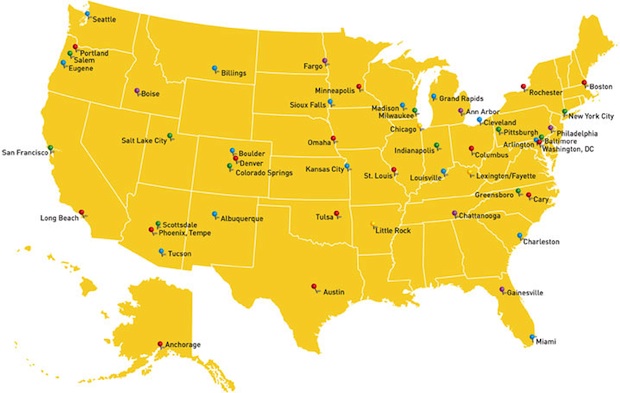 A startup company is developing a flat-panel source of x-rays that could help make the imaging technique portable. The company's panels are made using techniques commonplace in the semiconductor industry and would be combined with flat-panel image sensors to make a briefcase-sized x-ray machine powered by a laptop battery. Such a system might be used in the field by the military or instead of bulky bedside systems used in hospital intensive-care units. Early research also suggests it might expose patients to less radiation.
A startup company is developing a flat-panel source of x-rays that could help make the imaging technique portable. The company's panels are made using techniques commonplace in the semiconductor industry and would be combined with flat-panel image sensors to make a briefcase-sized x-ray machine powered by a laptop battery. Such a system might be used in the field by the military or instead of bulky bedside systems used in hospital intensive-care units. Early research also suggests it might expose patients to less radiation.
 The company behind the x-ray source, Radius Health,
was spun out of the University of California, Los Angeles last year. It
is developing a commercial version of a flat-panel x-ray source
developed by physicists at the university. The company will make its
first complete x-ray imager in three to four months and says it will
have a full-scale prototype in a year.
The company behind the x-ray source, Radius Health,
was spun out of the University of California, Los Angeles last year. It
is developing a commercial version of a flat-panel x-ray source
developed by physicists at the university. The company will make its
first complete x-ray imager in three to four months and says it will
have a full-scale prototype in a year.
The x-ray machines used in hospitals today employ a high-energy source of the radiation. A tungsten filament at one end of a long vacuum tube emits electrons when heated and those accelerate down the tube until they hit a metal electrode, causing it to produce x-rays.

 Dave Duffield is back in a cubicle after building PeopleSoft into a giant, then losing it in a brutal takeover battle with Larry Ellison. How at 70 he's planning his return — and his IPO.
Dave Duffield is back in a cubicle after building PeopleSoft into a giant, then losing it in a brutal takeover battle with Larry Ellison. How at 70 he's planning his return — and his IPO.

 Starting your own business can be one of the best decisions you ever make in your life. There are many advantages to starting your own business such as independence and control over your potential salary. While all of these benefits are great, there is a lot of misinformation about what it takes to become an entrepreneur. (Find out if you have what it takes in Are You An Entrepreneur?)
Starting your own business can be one of the best decisions you ever make in your life. There are many advantages to starting your own business such as independence and control over your potential salary. While all of these benefits are great, there is a lot of misinformation about what it takes to become an entrepreneur. (Find out if you have what it takes in Are You An Entrepreneur?) t now takes almost as long to get a job in the U.S. — seven and a half months — as it does to produce your next of kin. That’s the longest slog since the Labor Department began tracking job search duration in 1948. Looked at another way, there are currently an average of six people vying for every job that you are, each of them doing exactly the same things — combing job boards, networking, prepping for interviews — as you. Is there a way to speed up the job search and stand out from your competition?
t now takes almost as long to get a job in the U.S. — seven and a half months — as it does to produce your next of kin. That’s the longest slog since the Labor Department began tracking job search duration in 1948. Looked at another way, there are currently an average of six people vying for every job that you are, each of them doing exactly the same things — combing job boards, networking, prepping for interviews — as you. Is there a way to speed up the job search and stand out from your competition? "If you have done just one, you don't know the 100 different pieces
of the value chain and the market segment," says CMEA Capital's Rachel
Sheinbein, who used to help Intel address wastewater challenges.
"Something else comes in and it is totally different. It is like saying
'energy.' There are so many pieces of [the water market]."
"If you have done just one, you don't know the 100 different pieces
of the value chain and the market segment," says CMEA Capital's Rachel
Sheinbein, who used to help Intel address wastewater challenges.
"Something else comes in and it is totally different. It is like saying
'energy.' There are so many pieces of [the water market]."  First of all, I would like to thank the Spanish Presidency of the European Union for organizing this important and timely forum.
First of all, I would like to thank the Spanish Presidency of the European Union for organizing this important and timely forum.

 This question comes up a lot especially amongst small
business owners and entrepreneurs: How do I make money from
blogging?
This question comes up a lot especially amongst small
business owners and entrepreneurs: How do I make money from
blogging? For Maine businesses to thrive, they must innovate. And for the University of Maine System to produce the workers those businesses need, the system must innovate as well.
For Maine businesses to thrive, they must innovate. And for the University of Maine System to produce the workers those businesses need, the system must innovate as well. Now researchers at the University of Florida have engineered a smart
pill with a tiny antenna and microchip that could signal when it has
made it into a patient's stomach--reporting to a cell phone or computer
that she has taken her medicine. Their design is the latest of
Now researchers at the University of Florida have engineered a smart
pill with a tiny antenna and microchip that could signal when it has
made it into a patient's stomach--reporting to a cell phone or computer
that she has taken her medicine. Their design is the latest of 


 When they started their business, a lack of capital was a worry for partners Mary Rogers and Rosemary Hartnett.
When they started their business, a lack of capital was a worry for partners Mary Rogers and Rosemary Hartnett. U2 singer Bono's stake in
U2 singer Bono's stake in  Veteran Wall Street Journal tech critic Walter Mossberg has been testing the iPad for the past week. The device has "the potential to change portable computing profoundly," Mossberg wrote, in a column published Thursday.
Veteran Wall Street Journal tech critic Walter Mossberg has been testing the iPad for the past week. The device has "the potential to change portable computing profoundly," Mossberg wrote, in a column published Thursday.